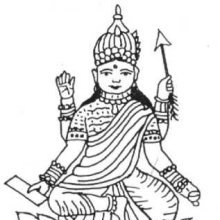Siddhayika, Siddhāyikā: 6 definitions
Introduction:
Siddhayika means something in Jainism, Prakrit, Hinduism, Sanskrit. If you want to know the exact meaning, history, etymology or English translation of this term then check out the descriptions on this page. Add your comment or reference to a book if you want to contribute to this summary article.
Images (photo gallery)
In Jainism
General definition (in Jainism)
Source: archive.org: The Jaina IconographySiddhāyikā (सिद्धायिका) is the name of the Yakṣiṇī accompanying Mahāvīra: the last of twenty-four Tīrthaṃkaras or Jinas, commonly depicted in Jaina iconography.—Mahāvīra, the twenty-fourth or the last Jina is the greatest of all the Tīrthaṃkaras. His position is of unchallenged eminence in the Jaina religion, history and iconography. Being the Lion among the Jaina prophets, rightly given was his emblem of a lion. His Yakṣa spirits are respectively known as Mātaṅga and Siddhāyikā. The Magadhan King Śreṇika or better known as Bimbisāra acts as his Chowri-bearer. His Kevala tree is called Sāla (L. Shorca robusta).
This Yakṣiṇī of Mahāvīra in the account of the Śvetāmbaras, should ride a lion and have four hands carrying a book, Abhaya, Citrus, and lute (Vṇā). The Digambara counterpart of the goddess is represented as also riding upon a lion and holding a Varada-mudrā and book. The most important symbol connected with Siddhāyikā is her lion. This may be interpreted in the light of the same symbol as assumed by the Yakṣiṇī’s master Mahāvīra. Her other symbol, such as a book and Vīṇā (lute) would make her, in appearance, a Vidyādevī. The custom or giving a lion to a Goddess of learning does not appear to be singular to the Jainas as we find the Vāgīśvarī of Benares is seated on a lion’s back. Siddhāyikā’s other symbol is a citrus and this is particularly indicative of her Yakṣiṇī nature.

Jainism is an Indian religion of Dharma whose doctrine revolves around harmlessness (ahimsa) towards every living being. The two major branches (Digambara and Svetambara) of Jainism stimulate self-control (or, shramana, ‘self-reliance’) and spiritual development through a path of peace for the soul to progess to the ultimate goal.
Languages of India and abroad
Sanskrit dictionary
Source: Cologne Digital Sanskrit Dictionaries: Shabda-Sagara Sanskrit-English DictionarySiddhāyikā (सिद्धायिका).—f.
(-kā) One of the tutelary goddesses of the Jainas.
Source: Cologne Digital Sanskrit Dictionaries: Monier-Williams Sanskrit-English DictionarySiddhāyikā (सिद्धायिका):—[from sidh] f. ([probably] for siddha-dāyikā) Name of one of the 24 goddesses (called Śāsana-devatās) who execute the commands of the 24 Arhats, [cf. Lexicographers, esp. such as amarasiṃha, halāyudha, hemacandra, etc.]
Source: Cologne Digital Sanskrit Dictionaries: Yates Sanskrit-English DictionarySiddhāyikā (सिद्धायिका):—(kā) 1. f. One of the tutelary goddesses of the Jaina.
Source: DDSA: Paia-sadda-mahannavo; a comprehensive Prakrit Hindi dictionary (S)Siddhāyikā (सिद्धायिका) in the Sanskrit language is related to the Prakrit word: Siddhāiyā.
[Sanskrit to German]
Sanskrit, also spelled संस्कृतम् (saṃskṛtam), is an ancient language of India commonly seen as the grandmother of the Indo-European language family (even English!). Closely allied with Prakrit and Pali, Sanskrit is more exhaustive in both grammar and terms and has the most extensive collection of literature in the world, greatly surpassing its sister-languages Greek and Latin.
See also (Relevant definitions)
Full-text: Siddhaiya, Bimbisara, Shrenika, Mahavira, Matanga.
Relevant text
Search found 3 books and stories containing Siddhayika, Siddhāyikā; (plurals include: Siddhayikas, Siddhāyikās). You can also click to the full overview containing English textual excerpts. Below are direct links for the most relevant articles:
Jain Remains of Ancient Bengal (by Shubha Majumder)
Tīrthaṅkara Mahāvīra (Introduction) < [Chapter 6 - Iconographic Study of Jaina Sculptural Remains]
The twenty-four Tīrthaṅkaras and their Yakṣas and Yakṣiṇīs < [Chapter 6 - Iconographic Study of Jaina Sculptural Remains]
Trishashti Shalaka Purusha Caritra (by Helen M. Johnson)
Part 2: Mahāvīra’s śāsanadevatās (messenger-deities) < [Chapter V - Mahāvīra’s omniscience and the originating of the fourfold congregation]
Jainism in Odisha (Orissa) (by Ashis Ranjan Sahoo)
Iconography of Sasanadevis < [Chapter 6]
Iconography of Jain Gods and Goddess < [Chapter 6]
